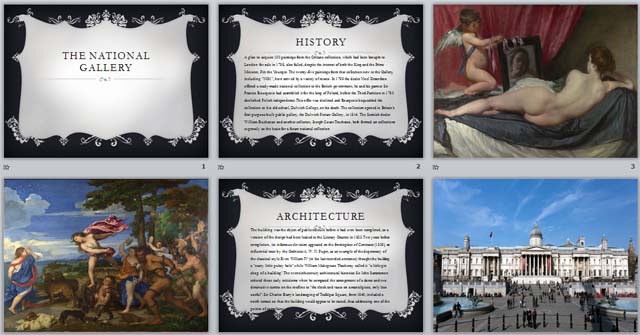
The National gallery

history
A plan to acquire 150 paintings from the Orléans collection, which had been brought to London for sale in 1798, also failed, despite the interest of both the King and the Prime Minister, Pitt the Younger. The twenty-five paintings from that collection now in the Gallery, including "NG1", have arrived by a variety of routes. In 1799 the dealer Noel Desenfans offered a ready-made national collection to the British government; he and his partner Sir Francis Bourgeois had assembled it for the king of Poland, before the Third Partition in 1795 abolished Polish independence.This offer was declined and Bourgeois bequeathed the collection to his old school, Dulwich College, on his death. The collection opened in Britain's first purpose-built public gallery, the Dulwich Picture Gallery, in 1814. The Scottish dealer William Buchanan and another collector, Joseph Count Truchsess, both formed art collections expressly as the basis for a future national collection.



Architecture
The building was the object of public ridicule before it had even been completed, as a version of the design had been leaked to the Literary Gazette in 1833.Two years before completion, its infamous elevation appeared on the frontispiece of Contrasts (1836), an influential tract by the Gothicist A. W. N. Pugin, as an example of the degeneracy of the classical style.Even William IV (in his last recorded utterance) thought the building a "nasty little pokey hole",while William Makepeace Thackeray called it "a little gin shop of a building".The twentieth-century architectural historian Sir John Summerson echoed these early criticisms when he compared the arrangement of a dome and two diminutive turrets on the roofline to "the clock and vases on a mantelpiece, only less useful".Sir Charles Barry's landscaping of Trafalgar Square, from 1840, included a north terrace so that the building would appear to be raised, thus addressing one of the points of complaint.




Controversies
One of the most persistent criticisms of the National Gallery, apart from those who criticise inadequacies of the building, has been of its conservation policy. The Gallery's detractors accused it of having had an over-zealous approach to restoration. The first cleaning operation at the National Gallery began in 1844 after Eastlake's appointment as Keeper, and was the subject of attacks in the press after the first three paintings to receive the treatment – a Rubens, a Cuyp and a Velázquez – were unveiled to the public in 1846.The Gallery's most virulent critic was J. Morris Moore, who wrote a series of letters to The Times under the pseudonym "Verax" savaging the institution's cleanings. While an 1853 Parliamentary Select Committee set up to investigate the matter cleared the Gallery of any wrongdoing, criticism of its methods has been erupting sporadically ever since from some in the art establishment.



Collection highlights
- English or French Medieval: The Wilton Diptych
- Jan van Eyck: The Arnolfini Portrait
- Pisanello: The Vision of Saint Eustace
- Paolo Uccello: The Battle of San Romano, Saint George and the Dragon
- Rogier van der Weyden: The Magdalen Reading
- Masaccio: Madonna and Child
- Dieric Bouts: The Entombment
- Piero della Francesca: The Baptism of Christ
- Antonello da Messina: Portrait of a Man, St Jerome in his Study
- Giovanni Bellini: The Agony in the Garden, Madonna del Prato, Portrait of Doge Leonardo Loredan

J. M. W. Turner, The Fighting Temeraire

Vincent van Gogh, Sunflowers

Hans Holbein, The Ambassadors

Jan van Eyck, The Arnolfini Portrait

Bibliography
- Barker, Felix; Hyde, Ralph (1982), London As It Might Have Been, London: John Murray
- Bomford, David (1997), Conservation of Paintings, London: National Gallery Company
- Bosman, Suzanne (2008), The National Gallery in Wartime, London: National Gallery Company
- Conlin, Jonathan (2006), The Nation's Mantelpiece: A History of the National Gallery, London: Pallas Athene
- Crookham, Alan (2012), "The Turner Bequest at the National Gallery", in Warrell, Ian, Turner Inspired: In the light of Claude, New Haven and London: Yale University Press, pp. 51–65



 Получите свидетельство
Получите свидетельство Вход
Вход






























 The National gallery (презентация) (3.32 MB)
The National gallery (презентация) (3.32 MB)
 0
0 1185
1185 107
107 Нравится
0
Нравится
0


